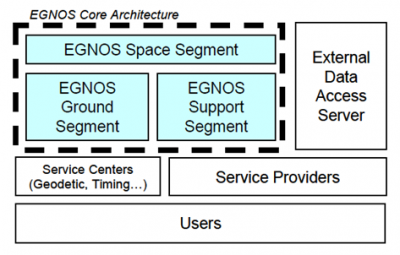If you wish to contribute or participate in the discussions about articles you are invited to contact the Editor
EGNOS General Introduction: Difference between revisions
(→References: better place in category list) |
|||
| Line 115: | Line 115: | ||
<references/> | <references/> | ||
[[Category:EGNOS| | [[Category:EGNOS|!]] | ||
Revision as of 10:53, 10 September 2014
| EGNOS | |
|---|---|
| Title | EGNOS General Introduction |
| Edited by | GMV |
| Level | Basic |
| Year of Publication | 2011 |
EGNOS (European Geostationary Navigation Overlay Service) is the European satellite-based augmentation service (SBAS) that complements the existing satellite navigation services provided by the US Global Positioning System (GPS). EGNOS provides the first European GNSS services to users.[1][2][3][4][5] EGNOS constitutes together with Galileo the two major initiatives in Europe in terms of satellite navigation.[6]
EGNOS Services
EGNOS supports the following services:[7]
- The Open Service (OS), freely available to the public over Europe. This service was officially started on 1 October 2009.
- The Safety of Life Service (SoL), that provides the most stringent level of signal-in-space performance to all communities of Safety of Life users over Europe. This service was officially started on 2 March 2011.
- The Commercial Data Distribution Service (CDDS) for customers who require enhanced performance for commercial and professional use. This service is being provided since April 2010.[8]
EGNOS is meant to be part of a multi-modal inter-regional SBAS service, supporting a wide spectrum of applications in many different users’ communities. In particular the EGNOS service can support different applications in the transport domain (e.g. aviation, maritime and rail). This service is compliant with already well identified safety-critical aviation applications, as APV (Approach with vertical Guidance).
EGNOS Architecture
The EGNOS Core architecture is composed of the following segments:[3]
- Ground segment , composed of reference stations (RIMS - Ranging & Integrity Monitoring Stations) spread inside and outside Europe which monitor the GPS satellites; control centers (MCC - Mission Control Centers) and uplink stations (NLES - Navigation Land Earth Stations);
- Space segment, composed of GEO satellites broadcasting EGNOS Signal In Space (SIS) over the service area;
- Support segment, composed of the Performance Assessment Check-out Facility (PACF) and the Application Specific Qualification Facility (ASQF);
In addition, the following elements are present in the EGNOS architecture, but are outside of the EGNOS Core:
- External Data Access Server, for the distribution to customers of EGNOS products enabling the EGNOS Commercial Data Distribution Service (CDDS).
- User segment, composed of the EGNOS receiver and user terminals.
EGNOS processing channel starts with each RIMS collecting raw data from the GPS satellites and EGNOS GEO satellites in view and transmitting them to the MCCs. Then the Central Processing Facility (CPF) inside each MCC facility computes signal corrections in real time including ionospheric delays, GPS and GEO ephemeris and clock errors. Finally, the EGNOS signal and data are sent to the users via a GEO satellite link, with the NLES acting as uplink stations, and through the External Data Access Server.
EGNOS Performances
According to EGNOS Mission Requirement Document,[3] EGNOS performances required are presented in the following table.
| Service | Service Coverage | Accuracy (95%) | Integrity | Continuity | Availability | ||||
|---|---|---|---|---|---|---|---|---|---|
| Lateral | Vertical | HAL | VAL | TTA | Integrity Risk | ||||
| Open Service | EU25 States (plus Norway and Switzerland) land masses | 3m | 4m | - | - | - | - | - | 99% |
| SoL En-route and NPA | FIRs of ECAC 96 | 220m | - | 556m | - | 10s | 1e-7/hour | 1e-5/hour | 99.9% |
| SoL APV-I | Land Masses of ECAC 96 | 16m | 20m | 40m | 50m | 6s | 2e-7/150s | 8e-6/15s | 99% |
However, actual EGNOS Performances may differ from the required ones. EGNOS is in a continuous process of enhancement with the aim of improving the performances and robustness of the system. Actual EGNOS performances are being monitored and analyzed continuously by ESSP (http://egnos-user-support.essp-sas.eu/egnos_ops) and ESA (http://www.egnos-pro.esa.int/IMAGEtech/imagetech_realtime.html) amongst other entities.
EGNOS Signal Structure
The EGNOS Signal Structure is compliant with the ICAO SARPs for SBAS[9] as stated in the EGNOS Open Service Service Definition Document and the EGNOS Safety of Life Service Definition Document.[10][4] The EGNOS SIS interface characteristics comprise carrier and modulation radio frequency, message structure, protocol and content of the EGNOS message (detailed in the EGNOS Message Format definition).
EGNOS uses the same frequency (L1 1575.42 MHz)) and ranging codes as GPS, but has a different data message format. Sixteen different message types have so far been defined to broadcast integrity data and Wide Area Differential (WAD) corrections. The message schedule follows a 6-second duty cycle in line to the standards (ICAO SARPs [9]).
Integrity is provided at two levels: use/don’t use flags for satellites and for ionospheric grid points; and two parameters – UDRE and GIVE – that are statistical estimates of the satellite and ionospheric errors remaining after applying the WAD corrections. These are used to compute a certified error bound for the position solution in an integrity assessment.
Fast and slow WAD corrections model the temporal de-correlation of the different error sources. The fast corrections model rapidly changing error sources including satellite clock errors. The slow corrections model more slowly changing error sources including long-term satellite clock drift and ephemeris errors. Ionospheric delays are provided at pre-defined grid points.
At user level, the receiver estimates corrections for satellite clock and ephemeris errors using the fast and slow satellite data messages. It has to account for both range-rate effects between successive fast corrections and performance degradation if a message is missed. The UDRE term characterizes statistically the residual range errors after having applied the fast and slow clock and ephemeris corrections.
The receiver predicts also ionospheric delays for each range in three steps: it estimates where the view line from satellite to receiver pierces the ionospheric layer; the vertical delay at the pierce point is then interpolated from the surrounding grid points which have been estimated by the system; and finally the estimated delay is applied to the range measurement. The GIVE term is applied to the range vector to characterize statistically the residual ionospheric errors.
Tropospheric errors may be mitigated using a simple model related to the receiver’s position and the day of year.
For more information, please refer to the EGNOS Signal Structure article.
SBAS Interoperability
SBAS Interoperability refers to the ability of two or more SBAS systems to be used together to provide better capabilities at user level than those achieved by relying solely on one of the systems.
The SBAS interoperability has always been a pre-requisite for delivering a global seamless safety-of-life service. This was recognized early on by SBAS developers and air traffic services providers, and they have worked closely together to co-ordinate their activities at the International Civil Aviation Organization (ICAO) and in the Interoperability Working Group (IWG). One of their key activities has been to assist ICAO and the Radio Technical Commission for Aeronautics (RTCA) in the development of standards: Standards and Recommended Practices (SARPS) for system developers and Minimum Operational Performance Standards (MOPS) for receiver manufacturers.
The combination of SBAS interoperability and expansion concepts should allow the provision of a truly global and seamless navigation service.
EGNOS Future and Evolutions
The European Commission (EC) intends to ensure the future of EGNOS services for a minimum period of 20 years, as from its first declaration date, with 6 years advance notice in case of significant changes in the Services provided[4]. In this context, the budget should be secured to operate the system and manage the system obsolescence. Moreover, major EGNOS system evolutions towards a multi frequency and multi constellation configuration are currently being assessed with the objective to have them operational by 2020.[11]
Notes
References
- ^ 98/434/EC: Council Decision of 18 June 1998 concerning the Agreement between the European Community, the European Space Agency and the European Organisation for the Safety of Air Navigation on a European contribution to the development of a global navigation satellite system (GNSS)
- ^ Regulation (EC) No 683/2008 of the European Parliament and of the Council of 9 July 2008 on the further implementation of the European satellite navigation programmes (EGNOS and Galileo)
- ^ a b c EGNOS Mission Requirements Document, version 2.0, 8th May 2006, Galileo Joint Undertaking
- ^ a b c EGNOS Safety of Life Service Definition Document, Ref : EGN-SDD SoL, V1.0, European Commission, Directorate-General for Enterprise and Industry, 2011.
- ^ EGNOS − The European Geostationary Navigation Overlay System − A Cornerstone of Galileo (ESA SP-1303)
- ^ Brussels, 18.1.2011 COM(2011) 5 final Report from the Commission to the European Parliament and the Council - Mid-term review of the European satellite radio navigation programmes
- ^ http://egnos-portal.gsa.europa.eu/discover-egnos/services/service-access
- ^ http://www.essp-sas.eu/news
- ^ a b SARPS Amendment 77, Annex 10 to the Convention on International Civil Aviation, Aeronautical Telecommunications: International Standards and Recommended Practices, Volume 1, Radio Navigation Aids, November 2002.
- ^ EGNOS Open Service Definition Document
- ^ Analysis Of Safety Of Life Service Provision For The European GNSS Elements, EGPC-10-04-23-04, 16 April 2010, European GNSS Programmes Committee, European Commission



